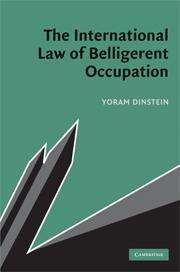Book contents
- Frontmatter
- Contents
- Preface
- Table of cases
- Table of treaties
- Table of UN Resolutions
- List of abbreviations
- 1 The general framework
- 2 The legal nature and basic principles of belligerent occupation
- 3 Human rights and belligerent occupation
- 4 The maintenance of law and order in occupied territories
- 5 Legislation by the Occupying Power
- 6 The judicial system in occupied territories
- 7 Protection of the civilian population under belligerent occupation
- 8 Special protection in occupied territories
- 9 Destruction and pillage of property in occupied territories
- 10 Seizure and use of property in occupied territories
- 11 Other major issues relating to belligerent occupation
- 12 The termination of belligerent occupation
- Conclusion
- Index of persons
- Index of subjects
- References
9 - Destruction and pillage of property in occupied territories
Published online by Cambridge University Press: 24 January 2011
- Frontmatter
- Contents
- Preface
- Table of cases
- Table of treaties
- Table of UN Resolutions
- List of abbreviations
- 1 The general framework
- 2 The legal nature and basic principles of belligerent occupation
- 3 Human rights and belligerent occupation
- 4 The maintenance of law and order in occupied territories
- 5 Legislation by the Occupying Power
- 6 The judicial system in occupied territories
- 7 Protection of the civilian population under belligerent occupation
- 8 Special protection in occupied territories
- 9 Destruction and pillage of property in occupied territories
- 10 Seizure and use of property in occupied territories
- 11 Other major issues relating to belligerent occupation
- 12 The termination of belligerent occupation
- Conclusion
- Index of persons
- Index of subjects
- References
Summary
Destruction of property
The general prohibition
461. When hostilities take place – in or out of occupied territories – the destruction of some civilian property is an almost inexorable result of the fighting. This will happen for any number of reasons. Shellfire may be directed against enemy combatants holding out in an urban or rural locality – wrecking buildings and torching crops – or a line of fire may be cleared in cultivated lands. Potential enemy fortifications may be pulverized, trenches and dugouts may have to be shovelled in tilled soil, tanks may have to ride over farmlands, and so forth. The cardinal rule of LOIAC is that enemy property (and in this context there is no distinction between movable or immovable, private or public, property) must not be destroyed, except for reasons of military necessity. Hague Regulation 23(g) formulates the general prohibition ‘[t]o destroy or seize the enemy's property, unless such destruction or seizure be imperatively demanded by the necessities of war’. This is also a war crime under Article 8(2)(b)(xiii) of the Rome Statute of the International Criminal Court. But it is clear that, when ‘imperatively demanded by the necessities of war’, enemy property may be destroyed.
462. The International Court of Justice expressed the view, in the Advisory Opinion on the Wall, that – since Hague Regulation 23(g) appears in the section of the text devoted to hostilities, rather than belligerent occupation – it is not ‘pertinent’ to occupied territories.
- Type
- Chapter
- Information
- The International Law of Belligerent Occupation , pp. 195 - 209Publisher: Cambridge University PressPrint publication year: 2009



